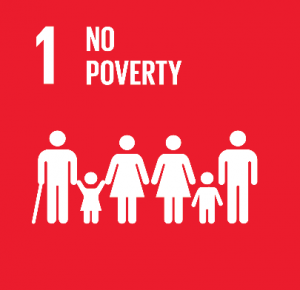This week’s guest blog comes second in a series of blogs on the Sustainable Development Goals (SDGs) courtesy of Onna Malou van den Broek, second year doctorate student at King’s in the European & International Studies Department. Onna’s doctorate project titled: ‘The Political Payoff of Corporate Social Responsibility (CSR): CSR as a Determinant for Lobbying Success’, looks at the relationship between corporate sustainability and lobbying, holding a special focus on the SDGs.
Poverty in all its forms everywhere is, according to the United Nations (UN), stating that it is one of the biggest challenges of our generation. The good news is that the amount of people living in extreme poverty has relatively decreased from 28 percent in 1999 to 11 percent in 2013. The bad news, however, is that over 896 million people are still living with less than $1.90 per day, mainly within South-Asia and Sub-Saharan Africa (1). Poverty goes beyond the lack of financial resources; it reflects a lack of opportunities, which are often linked to education, healthcare, discrimination and hunger.
“Overcoming poverty is not a task of charity, it is an act of justice”
Nelson Mandela
The Targets: Eradicating Poverty and Creating Social Security
The seven SDG targets that aim to diminish poverty by 2030 include both a financial and a social dimension. A distinction is made between extreme poverty measured as people living on less than $1.25 a day and general poverty measured according to national definitions. Whereas extreme poverty must be overcome completely, general poverty must be halved. On a national level, the targets are three-fold: strengthening the resilience of the poor, particularly in cases of natural disasters; implementing social policies that protect citizen against poverty and; creating equal rights and access to economic resources and services. On an international level, the targets press states to actively mobilize resources that can combat poverty and to create policies that target and benefit the poorest.
Progress? Measuring Regional Inequality
Without measurements there is no knowledge of progress. In the previous blog, I explained that each goal is broken down in targets which are measured by indicators. The UN created a database which tracks down how each country is currently doing on each indicator. Have a look around yourself as this database is accessible for everyone (2). Looking at the data, the general trend seems to be that regional inequality is on the rise. Let’s zoom in on social security, which is crucial to battle poverty. A total of 45 percent of the world’s population has access to at least one type of social insurance. A simple comparison illustrates the imbalance: in Western Europe this percentages is 99, whereas in West Africa it is merely 9 percent.
Oxfam and the UN: Business against poverty
There are countless projects that intend to contribute towards SDG 1, but as I specialise in business I would like to focus on the partnership between Oxfam and the UN (3). This partnership aims to make companies aware of their positive and negative impact on local poverty. To accomplish this, they created the so-called ‘poverty footprint’. Through this online tool, companies can begin to understand how they affect poverty and adjust their business operations accordingly. A company that completed the poverty footprint is Unilever. They concluded that by offering more part-time instead of full-time jobs at their manufacture site in Kecap Bango, more people would be helped out of poverty in this Indonesian region. Thus, by measuring their influence on poverty, companies are urged to find innovative solutions.
The situation in Europe
Eurostat, the statistics centre of the European Union (EU), shows that in 2016 over 118 million people were at risk of poverty or social inclusion (see the Figure below). There is a wide disparity within the EU. To illustrate, in Bulgaria almost 42 percent of the population is at risk of poverty or social exclusion. In comparison, in Sweden this percentage is only 14. Furthermore, 36 percent of Greek people live below the national poverty line and 19 percent of Romanian people that are employed still live in poverty. In the UK, child poverty is taking a worrisome number; about 4 million children are classified as poor.
The Fund of Urgent Needs in the Netherlands.
The Netherlands, where I am originally from, does not know extreme poverty. Nonetheless, 10 percent of Dutch citizens live under the national poverty line of 33 euro per day. An organization within the Netherlands that aims to tackle local poverty is the Fund of Urgent Needs (SUN). My mother is the location manager in my home-town Leiden, where SUN offers financial aid to people that are in danger of falling between two stools. She explains that: “our foundation gives to the inhabitant of Leiden, who are in an urgent financial situation and do not apply for governmental help”.
What can you do in the fight against poverty?
The traditional way of donating money is, for the low-budget students, not always a possibility – nor might it be the most effective route. Luckily, there are other ways: you can volunteer at existing programmes, such as Child Poverty Action Group, Oxfam, foodbanks or ONE, or develop your own project at King’s. As poverty is rooted in various related problems, you can think about projects improving general live conditions as well. For example, become a reading helper for children at BeanStalk – with only a few hours a week you can ensure a child can read, grow and thrive!
References:
- More statistics, data and information on this goal can be found here.
- If you want to play a bit around with the target data on country level, you can either go to UNSTAT or the SDG index.
- Read more on the poverty footprint at Oxfam’s or the UN’s respectively websites.
- Unfortunately, in Dutch, but if you want to learn more about the situation in the Netherlands click here and for the foundation of urgent needs here.




